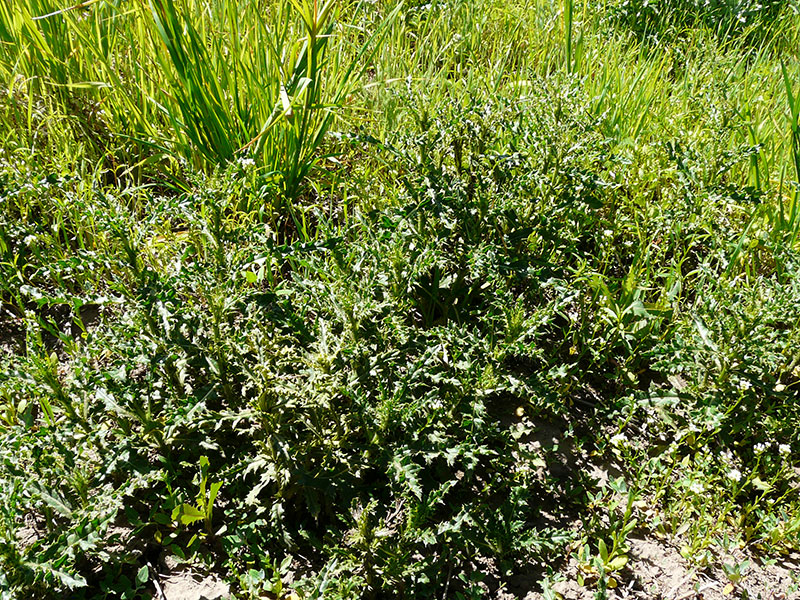Cirsium arvense / Canada thistle
- purple or lavender clearly-thistle flower heads
- multiple small flower heads per stem
- deeply lobed, spiny leaves, but stems not spiny
- clonal and perennial
- in clumps or along roads, sometimes quite large/long
Also known as: field thistle
See also: Carduus nutans (musk thistle), Cirsium vulgare (bull thistle).
Canada thistle is probably the most widespread of all thistle species. It is a weed – officially a noxious weed – and one of the most damaging in the state. Nationwide, Idaho leads all reporting states in estimated infested acreage. Of the 3 exotic thistles common to the Valley, Canada thistle is the most nefarious… which also makes it the most interesting, biologically.
Canada thistle can be easily identified as a thistle, and can be just as easily distinguished from other thistles. Like other thistles, it has deeply lobed, spiny leaves. It is has a rosette stage and a flowering stage, and it is found mostly in deeply disturbed habitats. Unlike musk and bull thistles, the flower heads are small (less than 1″ tall), and the stems are not conspicuously spiny-winged. Flower heads are only about 1/2 inch in diameter, and are not particularly spiny. The involucre is more elongated that other exotic thistles, and also not particularly spiny. It looks, perhaps, more like spotted knapweed than the other thistles.
Also unlike the other weedy thistles, Canada thistle shoots branch profusely with an inflorescence at the end of each one. Individual branches may have 1-5 flower heads; the other exotic thistles have just one. Flowering happens in midsummer because this is a “long-day” species, meaning it requires more than 15 hours of daylight to induce flowering (this limits its distribution in the southern states).
Canada thistle plants also differ from the other thistle species in that they are dioecious, meaning that male and female flowers are on different plants. Both attract insects, and pollen transfer is no problem for different sexed patches up to 200 feet apart. The seeds are tiny, and attached to a light brown pappus… a similar fruit to other thistles and many asteraceae. And like musk and bull thistle fruits, most often, the feathery pappus breaks off, so wind dispersal is not the main way that seeds spread. In the soil, seeds can remain viable for a couple decades at least, more if they are buried deeply.
As for its habitat, it likes disturbed ground, including ditch banks, overgrazed pastures, tilled fields or abandoned sites. It seems to interpret “disturbed” very loosely, however, and shows up on seemingly better sites often enough. Canada thistle can also tolerate up to 2 percent salt content in the soil, the only known salt tolerant plant on this site. In agricultural areas, hay transport and cultivation are major avenues for infestation. In “natural” areas, humans and beasts are vectors. Observations in Rocky Mountain National Park, for example, indicate that trails, especially those used by horses, are major invasion pathways.
So that is all the normal, background stuff. Now for the really interesting, life history/life cycle bits.
First, Canada thistle is seldom found as one plant; it occurs in patches which can easily expand until an entire field is infested. This trick is not based on high seed production, and Canada thistle has a reputation for producing few viable seeds.
Instead, Canada thistle is a creeping perennial that reproduces massively from vegetative buds in its root system. Adventitious roots from these buds can develop along the root at any location, and at any time of the year with favorable growing conditions. Depending on the time of year, the buds may develop into flowering shoots or rosettes, the latter happening in spring and in late fall.
The extensive root system also gives it the uncanny ability to survive major disturbance. At Mt. St. Helens, after the 1980 eruption, it survived landslides and resprouted from root and stem fragments.
The upshot of all this is that one plant, unchecked, can colonize an area 6 feet in diameter in a couple years. Large clones – single individuals – can reach diameters of more than 100 feet. In one experiment, Canada thistle produced some 360 feet of roots and 26 additional stem shoots in a little over 4 months. To make matters even more interesting, one of the more nefarious traits of Canada thistle is that small root pieces, a quarter inch long an an eighth inch in diameter, have enough stored energy to develop into new plants. These small roots can survive at least 100 days without nutrient replenishment from photosynthesis. And these teeny bits originate mostly from things like efforts to control it by tillage.
So, having made it through the growing season, what happens next? As days shorten, temperatures fall and soil nitrogen supplies dwindle in the fall, the plants put their energy into root growth and resource storage. This only happens as long as there are leaves to supply the sugars, however. After a truly killing frost, root growth stops. The plants go dormant and are all ready to start again when the snow melts.
| Color | |
|---|---|
| Family | |
| Blossom size | |
| Inflorescence size | |
| Inflorescence type | |
| When? | |
| Where? |


